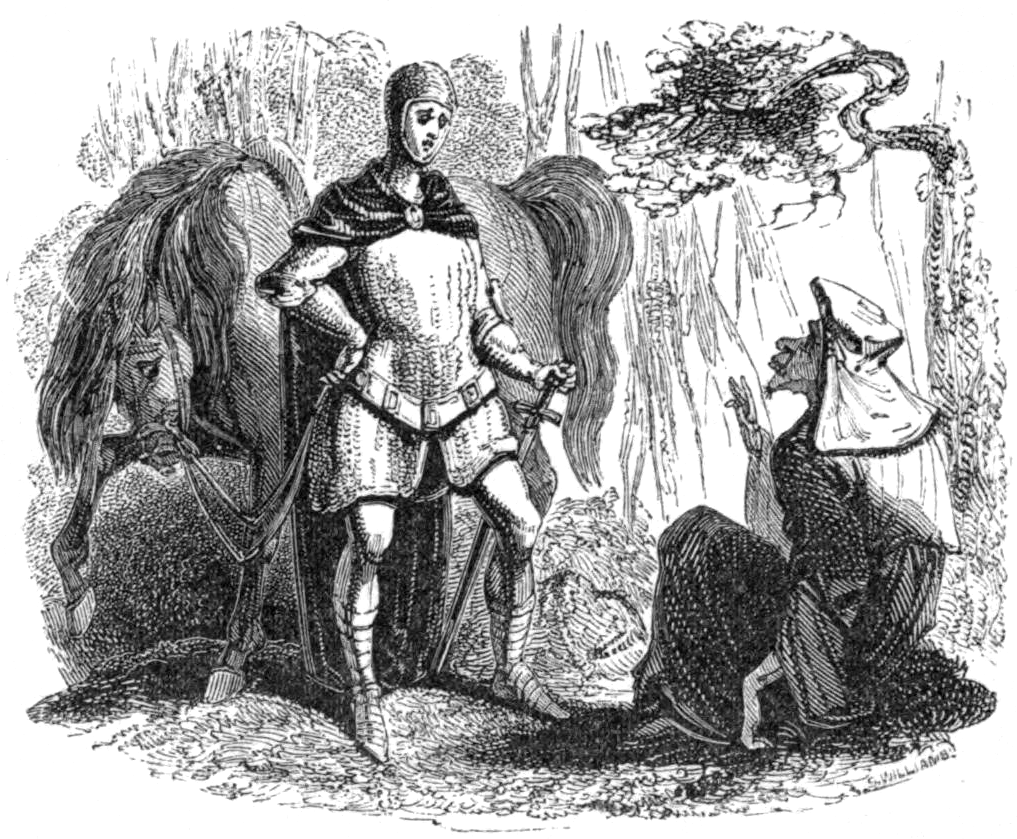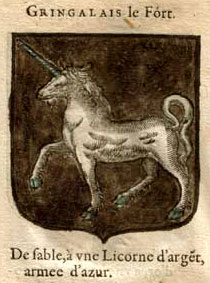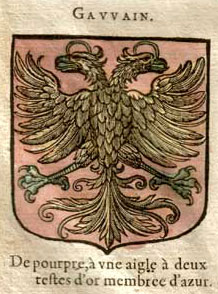|
The Wedding Of Sir Gawain And Dame Ragnelle
''The Wedding of Sir Gawain and Dame Ragnelle'' (''The Weddynge of Syr Gawen and Dame Ragnell'') is a 15th-century English poem, one of several versions of the "loathly lady" story popular during the Middle Ages. An earlier version of the story appears as "The Wyfe of Bayths Tale" ("The Wife of Bath's Tale") in Geoffrey Chaucer's '' The Canterbury Tales'', and the later ballad " The Marriage of Sir Gawain" is essentially a retelling, though its relationship to the medieval poem is uncertain. The author's name is not known, but similarities to '' Le Morte d'Arthur'' have led to the suggestion that the poem may have been written by Sir Thomas Malory. Text Stories about the Arthurian court were popular in medieval England, and the worn condition of some of the manuscripts suggests that they were well read. The Ragnelle narrative may have been intended for a festive or less than serious audience. Thomas Garbaty sees the poem as a humorous parody of the Arthurian legend, where Arthu ... [...More Info...] [...Related Items...] OR: [Wikipedia] [Google] [Baidu] |
Loathly Lady
The loathly lady ( cy, dynes gas, Motif D732 in Stith Thompson's motif index), is a tale type commonly used in medieval literature, most famously in Geoffrey Chaucer's '' The Wife of Bath's Tale''. The motif is that of a woman who appears unattractive (ugly, ''loathly'') but undergoes a transformation upon being approached by a man in spite of her unattractiveness, becoming extremely desirable. It is then revealed that her ugliness was the result of a curse which was broken by the hero's action. Irish legend The loathly lady can be found in ''The Adventures of the Sons of Eochaid Mugmedon'', in which Niall of the Nine Hostages proves himself the rightful High King of Ireland by embracing her, because she turns out to personify the sovereignty of the territory (and is therefore sometimes referred in scholarship as a ' sovereignty goddess'). The motif can also be found in stories of the earlier high kings Lugaid Loígde and Conn of the Hundred Battles. Diarmuid In the ... [...More Info...] [...Related Items...] OR: [Wikipedia] [Google] [Baidu] |
The Awntyrs Off Arthure
''The Awntyrs off Arthure at the Terne Wathelyne'' (''The Adventures of Arthur at Tarn Wadling'') is an Arthurian romance of 702 lines written in Middle English alliterative verse. Despite its title, it centres on the deeds of Sir Gawain. The poem, thought to have been composed in Cumberland in the late 14th or early 15th century, survives in four different manuscripts from widely separated areas of England. Synopsis Although the ''Awntyrs off Arthure'' is in some respects typical of the romances featuring Gawain, it has peculiarities of structure and theme that set it apart. It begins, conventionally enough, with Arthur's court riding out to a hunt. At the lake Tarn Wadling, Gawain and Guinevere ("Gaynour") encounter a hideous and vividly-described ghost, who reveals that she is Guinevere's mother, condemned to suffer for the sins of adultery and pride that she committed while alive. In response to Gawain and Guinevere's questions, she advises them to live morally and to "have ... [...More Info...] [...Related Items...] OR: [Wikipedia] [Google] [Baidu] |
Norris J
Norris or Noris may refer to: Places In Canada * Norris, Ontario, in Algoma District In the United Kingdom * Hampstead Norreys (or Norris), Berkshire In the United States * Norris, Illinois * Norris, Missouri Norris is an unincorporated community in Henry County, in the U.S. state of Missouri Missouri is a U.S. state, state in the Midwestern United States, Midwestern region of the United States. Ranking List of U.S. states and territories by are ... * Norris, Nebraska * Norris, South Carolina * Norris, Tennessee, named after George William Norris * Norris Dam, which forms Norris Lake, Tennessee * Norris Geyser Basin in Yellowstone National Park * Norristown, Pennsylvania * Lake Norris, Florida In Germany * Norisring, street circuit in Nuremberg People * Norris (surname), including Norris as a first name Companies * Norris Locomotive Works * Norisbank, a bank in Germany * T. Norris & Son, London, hand-tool makers Other * Noris (pencil), a ... [...More Info...] [...Related Items...] OR: [Wikipedia] [Google] [Baidu] |
Western Michigan University
Western Michigan University (Western Michigan, Western or WMU) is a Public university, public research university in Kalamazoo, Michigan. It was initially established as Western State Normal School in 1903 by Governor Aaron T. Bliss for the training of teachers. In 1957, G. Mennen Williams signed a bill into law that made Western a university and gave the school its current name of Western Michigan University. Western is one of the eight research universities in the State of Michigan and is Carnegie Classification of Institutions of Higher Education, classified among "R2: Doctoral Universities – High research activity". The university has seven degree-granting colleges, offering 147 undergraduate degree programs, 73 master's degree programs, 30 doctoral programs, and one specialist degree program. It is governed by an eight-member board of regents whose members are appointed by the governor of Michigan and confirmed by the Michigan Senate for eight-year terms. The university ... [...More Info...] [...Related Items...] OR: [Wikipedia] [Google] [Baidu] |
Fairy
A fairy (also fay, fae, fey, fair folk, or faerie) is a type of mythical being or legendary creature found in the folklore of multiple European cultures (including Celtic, Slavic, Germanic, English, and French folklore), a form of spirit, often described as metaphysical, supernatural, or preternatural. Myths and stories about fairies do not have a single origin, but are rather a collection of folk beliefs from disparate sources. Various folk theories about the origins of fairies include casting them as either demoted angels or demons in a Christian tradition, as deities in Pagan belief systems, as spirits of the dead, as prehistoric precursors to humans, or as spirits of nature. The label of ''fairy'' has at times applied only to specific magical creatures with human appearance, magical powers, and a penchant for trickery. At other times it has been used to describe any magical creature, such as goblins and gnomes. ''Fairy'' has at times been used as an adjective ... [...More Info...] [...Related Items...] OR: [Wikipedia] [Google] [Baidu] |
Libeaus Desconus
''Libeaus Desconus'' is a 14th-century Middle English version of the popular "Fair Unknown" story. Its author is thought to be Thomas Chestre. The story matter displays strong parallels to that of Renaut de Beaujeu's ''Le Bel Inconnu''; both versions describe the adventures of Gingalain, the son of King Arthur's knight Gawain and a fay who raises him ignorant of his parentage and his name. As a young man, he visits Arthur's court to be knighted, and receives his nickname; in this case Sir Libeaus Desconus, before setting forth on a series of adventures which consolidate his new position in society. He eventually discovers who is his father, and marries a powerful lady. Other versions of the story include the Middle High German romance ''Wigalois'' (1204–1209) by Wirnt von Gravenberc. The "Fair Unknown" story has parallels in the tale of La Cote Male Taile, Chrétien de Troyes' '' Conte du Graal'', Sir Thomas Malory's ''Tale of Sir Gareth'' from ''Le Morte d'Arthur'', and the 1 ... [...More Info...] [...Related Items...] OR: [Wikipedia] [Google] [Baidu] |
Thomas Chestre
Thomas Chestre was the author of a 14th-century Middle English romance ''Sir Launfal'', a verse romance of 1045 lines based ultimately on Marie de France's Breton lay '' Lanval''. He was possibly also the author of the 2200-line ''Libeaus Desconus'', a story of Sir Gawain's son Gingalain based upon similar traditions to those that inspired Renaut de Beaujeu's late-12th-century or early-13th-century Old French romance ''Le Bel Inconnu'', and also possibly of a Middle English retelling of the mid-13th-century Old French romance ''Octavian''. Geoffrey Chaucer parodied ''Libeaus Desconus'', among other Middle English romances, in his Canterbury Tale of ''Sir Thopas''. Sir Launfal The name Thomas Chestre occurs only once in medieval writings, in the single manuscript copy that remains of the late-14th-century Middle English verse romance ''Sir Launfal''. It is found in British Library MS Cotton Caligula A.ii, fols 35v-42v, dating from the first half of the 15th centuryLaskaya, Anne ... [...More Info...] [...Related Items...] OR: [Wikipedia] [Google] [Baidu] |
Gingalain
Sir Gingalain (Guinglain, Gingalin, Gliglois, Wigalois, etc.), also known as Le Bel Inconnu, or The Fair Unknown, is a character from Arthurian legend whose exploits are recorded in numerous versions of a popular medieval romance. His nickname differs depending on the version and language; he is known in English as Libeaus Desconus. He is the title character in ''Le Bel Inconnu'', a poem composed by Renaut de Beaujeu sometime between the mid-1180s and 1230, and in the (destroyed) 13-century manuscript, ''Gliglois''. It is uncertain, however, if the Gliglois of the medieval manuscript refers to Gawain's son or some other character in the "Fair Unknown" cycle. The basic outline of the romance is similar in most sources, with slight variations in emotional emphasis according to the author. Gingalain is the son of Sir Gawain by Blanchemal, a fay that Gawain meets in the forest. Blanchemal keeps Gingalain's identity a secret from him and never tells him about his lineage. He realises h ... [...More Info...] [...Related Items...] OR: [Wikipedia] [Google] [Baidu] |
Sovereignty
Sovereignty is the defining authority within individual consciousness, social construct, or territory. Sovereignty entails hierarchy within the state, as well as external autonomy for states. In any state, sovereignty is assigned to the person, body, or institution that has the ultimate authority over other people in order to establish a law or change an existing law. In political theory, sovereignty is a substantive term designating supreme legitimate authority over some polity. In international law, sovereignty is the exercise of power by a state. '' De jure'' sovereignty refers to the legal right to do so; '' de facto'' sovereignty refers to the factual ability to do so. This can become an issue of special concern upon the failure of the usual expectation that ''de jure'' and ''de facto'' sovereignty exist at the place and time of concern, and reside within the same organization. Etymology The term arises from the unattested Vulgar Latin's ''*superanus'', (itself derived ... [...More Info...] [...Related Items...] OR: [Wikipedia] [Google] [Baidu] |
Carlisle
Carlisle ( , ; from xcb, Caer Luel) is a city that lies within the Northern English county of Cumbria, south of the Scottish border at the confluence of the rivers Eden, Caldew and Petteril. It is the administrative centre of the City of Carlisle district which, (along with Cumbria County Council) will be replaced by Cumberland Council in April 2023. The city became an established settlement during the Roman Empire to serve forts on Hadrian's Wall. During the Middle Ages, the city was an important military stronghold due to its proximity to the Kingdom of Scotland. Carlisle Castle, still relatively intact, was built in 1092 by William Rufus, served as a prison for Mary, Queen of Scots in 1568 and now houses the Duke of Lancaster's Regiment and the Border Regiment Museum. In the early 12th century, Henry I allowed a priory to be built. The priory gained cathedral status with a diocese in 1133, the city status rules at the time meant the settlement became a city. ... [...More Info...] [...Related Items...] OR: [Wikipedia] [Google] [Baidu] |
Sir Gawain
Gawain (), also known in many other forms and spellings, is a character in Arthurian legend, in which he is King Arthur's nephew and a Knight of the Round Table. The prototype of Gawain is mentioned under the name Gwalchmei in the earliest Welsh sources. He has subsequently appeared in many Arthurian stories in Welsh, Latin, French, English, Scottish, Dutch, German, Spanish, and Italian, notably as the protagonist of the famous Middle English poem '' Sir Gawain and the Green Knight''. Other tales featuring Gawain as the central character include '' De Ortu Waluuanii'', '' Diu Crône'', '' Ywain and Gawain'', '' Golagros and Gawane'', '' Sir Gawain and the Carle of Carlisle'', '' L'âtre périlleux'', '' La Mule sans frein'', '' La Vengeance Raguidel'', '' Le Chevalier à l'épée'', '' The Awntyrs off Arthure'', '' The Greene Knight'', and '' The Weddynge of Syr Gawen and Dame Ragnell''. In Arthurian chivalric romance literature, Gawain is usually depicted as King Arthur's ... [...More Info...] [...Related Items...] OR: [Wikipedia] [Google] [Baidu] |








